
It was interesting this morning to see two magazine covers in my mailbox that resonated with each other, and which I think deserve attention:
1. The New Yorker magazine’s November cover for its AI Issue is a cartoonish treatment of Artificial Intelligence. Funny, insightful, and open to interpretations. (Hear more from artist Christoph Niemann. New Yorker also invites YOU to create your own cover using AI!)
2. Long Read, The Guardian’s new magazine, has a seductive title – and it leans into the antithesis of what we associate with readers in the mobile era. Wait, we keep hearing these are readers who are longing to get away from the fast-paced, snippet-driven world of digital content, right?
So, what do AI and Long Read have in common? Not much, unless we see them as trends in how content is produced, preferred, and consumed by the audience.
No one questions the impact of Artificial Intelligence on content creation. No one can stop it. Everyone has an opinion about AI.
The Guardian’s Long Read: a reaffirmation for print
Long Read, that is a different story. As I visit newsrooms around the planet, it is obvious that the marketing departments of many media houses tell editors to make stories short, to provide summaries, and to keep it short! Good advice, but I also remind journalists in my workshops that in the mobile era we observe two types of behavior: lean forward, and lean back.
This has been going on for several years. We lean forward into our mobile devices to get quick information throughout the day, but we also make choices about which of those stories we want to invest more time in, and lean back to read, later when time allows.
That is why I am not surprised that The Guardian is venturing into the world of Long Read.. It is responding to the audience’s desire for depth, analysis, and a scuba-dive sort of plunge into stories that need to be dissected beyond the key takeaways – which, of course, will always be important.
Joshua Benton, of Harvard’s Nieman Lab has written a piece on the arrival of Long Read, with a headline that should please everyone who believes in print:
Time is a flat circle, print edition: The Guardian has brought its Long Read franchise back to actual paper
Now on firmer financial ground, the U.K. newspaper seems more aware of its strengths — and of the strengths of the print medium
Long Read magazine is a 100-page magazine dedicated to long-form journalism. It features 10 of the Guardian’s best pieces from the past year and hit newsstands on November 11. The Guardian also has a weekly magazine that includes long reads, world news, and opinion. The Guardian has a history of long-form storytelling. Long Read on SoundCloud posted audio versions of long reads published online and in the newspaper.
This is what The Guardian editors say about their new product:
“We know that for many people, myself included, when it comes to long, immersive pieces, reading in print – without the distraction of your phone, or emails and notifications pinging in – is still the most satisfying reading experience, and one that should be cherished in a climate so saturated by disturbance,” says Chris Clarke, editorial creative director of The Guardian.
The first cover is a “type attack” treatment, with no visuals, but still classic and attractive. The magazine’s font of choice is a reconstruction of an old Guardian typeface called Mercury that provides a visual separation between the magazine and the publication’s daily news content.
Read more about this new magazine here:

The design of Long Read is elegant and inviting. It makes ample use of white space to seduce readers into the long texts of stories. I like the playful nature of opening spreads (no two are alike), and this one here capitalizes on big type for a headline that will resonate with readers:

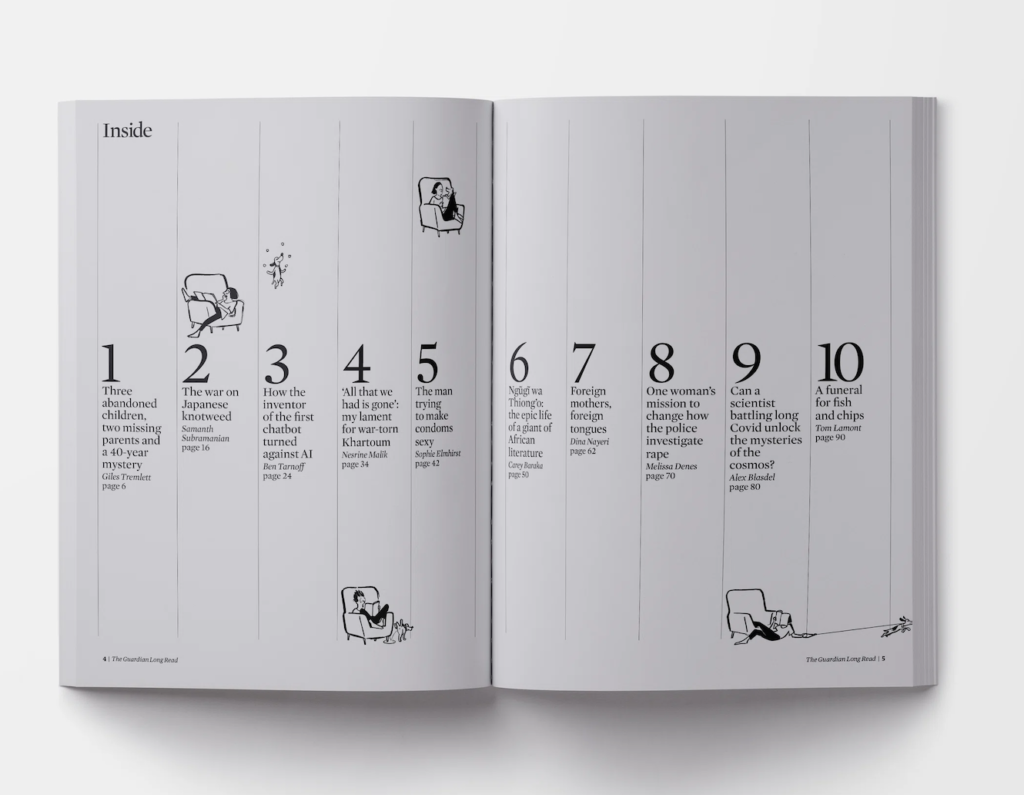

Long Read
X/Twitter: https://twitter.com/gdnlongread
It’s Nice That: “How The Guardian designed its thoughtful new long-form magazine”
The New Yorker

For readers of The New Yorker, cartoons and humor are an expected part of the reading experience. This cover does not disappoint. Using an illustration , it tells the story visually and quickly, inviting the reader to dive into a special issue dedicated to AI. Hear more from artist Christoph Niemann. New Yorker also invites YOU to create your own cover using AI!
The New Yorker piece is one of the most in-depth profiles of Geoffrey Hinton, the computer scientist who is often called “the godfather of A.I.” Written by Joshua Rothman, this narrative interview takes place at Mr. Hinton’s home in his own private island in Ontario, Canada. Anyone who is curious about Mr. Hinton, his early immersion into the world of Artificial Intelligence and his most recent comments about the threat that AI poses to humanity, should read this candid chat that takes us beyond the more scientific aspects of AI and into the personal life of Geoffrey Hinton, who lost his wife at 46 and raised his two children while also spending time in the laboratory experimenting with neural nets. It is his years of research leading to AI that give resonance to his latest statements about the “existential threat” that the technology might pose to the human species.
If you are beginning to use AI for your work as a content creator, the important takeaways from The New Yorker article, especially as we train in prompt engineering, are:
–AI comprehends the meaning of words and ideas: Hinton argues that the intelligence displayed by A.I. systems transcends its artificial origins. “Suppose you want to be really good at predicting the next word. If you want to be really good, you have to understand what’s being said. That’s the only way. So by training something to be really good at predicting the next word, you’re actually forcing it to understand. Yes, it’s ‘autocomplete’—but you didn’t think through what it means to have a really good autocomplete.” Hinton thinks that “large language models,” such as GPT, which powers OpenAI’s chatbots, can comprehend the meanings of words and ideas.
–Understand the idea of “connectionism”–an approach to artificial intelligence (AI) that developed out of attempts to understand how the human brain works at the neural level and, in particular, how people learn and remember. Word associations is a term we use to describe what comes to mind at the mention of a word, say blue: sky, sea. Connectionism, in the world of AI, works at a similar level. Connectionist models process information through a network of interconnected nodes. Understanding this can help in crafting prompts that align with how the AI processes and interprets language, leading to more effective and targeted responses.
–Understand “distillation”–This, to me, is key for effective prompt engineering, in which we know that the more descriptive the prompt, the better results we can expect from the robot. In Hinton’s own words:
“Back in school, the art teacher would show us some slides and say, ‘That’s a Rubens, and that’s a van Gogh, and this is William Blake.’ But suppose that the art teacher tells you, ‘O.K., this is a Titian, but it’s a peculiar Titian because aspects of it are quite like a Raphael, which is very unusual for a Titian.’ That’s much more helpful. They’re not just telling you the right answer—they’re telling you other plausible answers.” In distillation learning, one neural net provides another not just with correct answers but with a range of possible answers and their probabilities. It was a richer kind of knowledge.”
Distillation is about boiling down information to its essence. Journalists should be encouraged to distill their prompts to the most critical elements. This means avoiding overly verbose or vague prompts and instead focusing on clear, concise, and specific questions or instructions. This clarity helps the AI to zero in on exactly what is needed, avoiding irrelevant or tangential content.
And the part of the article that will give AI skeptics a bit of a pause:
“Hinton is convinced that there’s a real sense in which neural nets are capable of having feelings. “I think feelings are counterfactual statements about what would have caused an action,” he had told me, earlier that day. “Say that I feel like punching someone on the nose. What I mean is: if I didn’t have social inhibitions—if I didn’t stop myself from doing it—I would punch him on the nose. So when I say ‘I feel angry,’ it’s a kind of abbreviation for saying, ‘I feel like doing an aggressive act.’ Feelings are just a way of talking about inclinations to action.”
In the end, Hinton declares what we hear often about AI:
“There are two approaches to A.I. There’s denial, and there’s stoicism. Everybody’s first reaction to A.I. is ‘We’ve got to stop this.’ Just like everybody’s first reaction to cancer is ‘How are we going to cut it out?’ ” But it was important to recognize when cutting it out was just a fantasy.”
“We can’t be in denial,” he said. “We have to be real. We need to think, How do we make it not as awful for humanity as it might be?”
That, in my view as a content creator and an educator, is the task at present. How can we see AI as providing benefits in helping us with tasks that are monumentally difficult and time consuming for humans to execute, but always aware that we lead in this dance between human and robot. The optimist in me sees AI as contributing to humanity, and we are only embarking on the journey.
This quote from Hinton sums it up best:
“A.I. is just so useful. It has so much potential to do good, in fields like medicine—and, of course, to give an advantage to a nation via autonomous weapons.”
Geoffrey Hinton
Pre-order my new AI book here
https://thaneandprose.com/…/preorder-ai-what-to-expect…
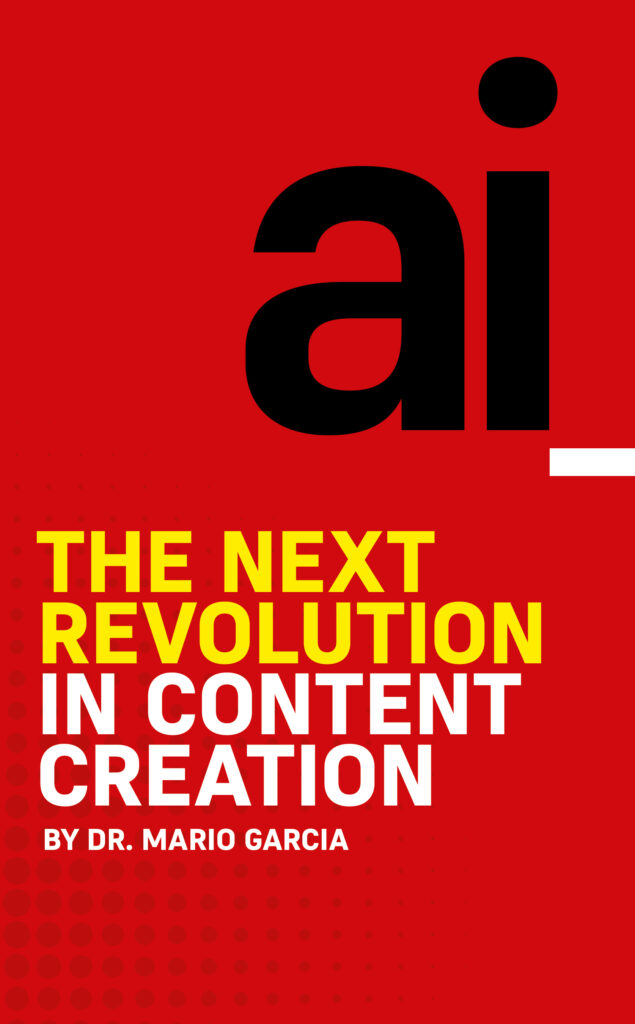
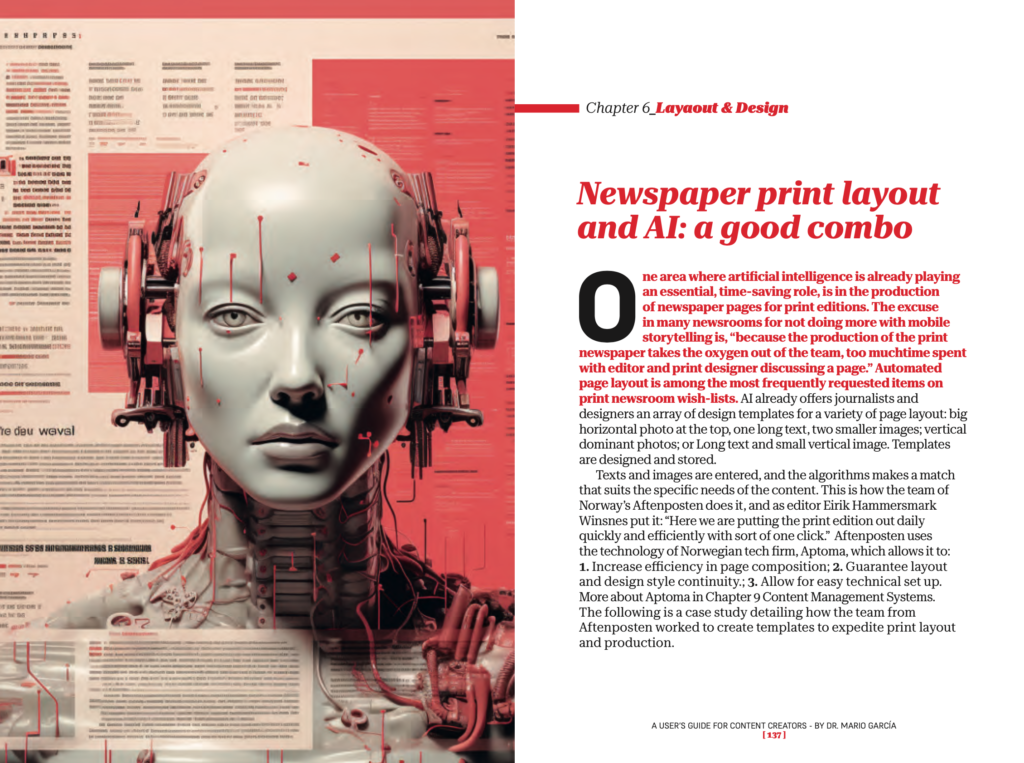
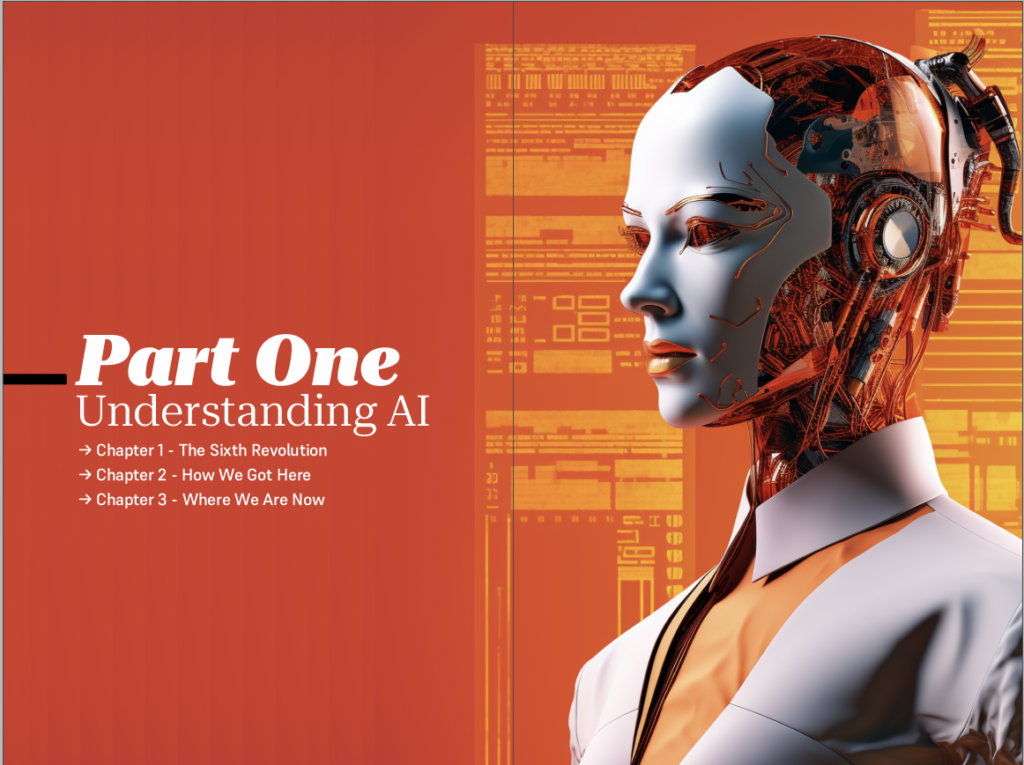
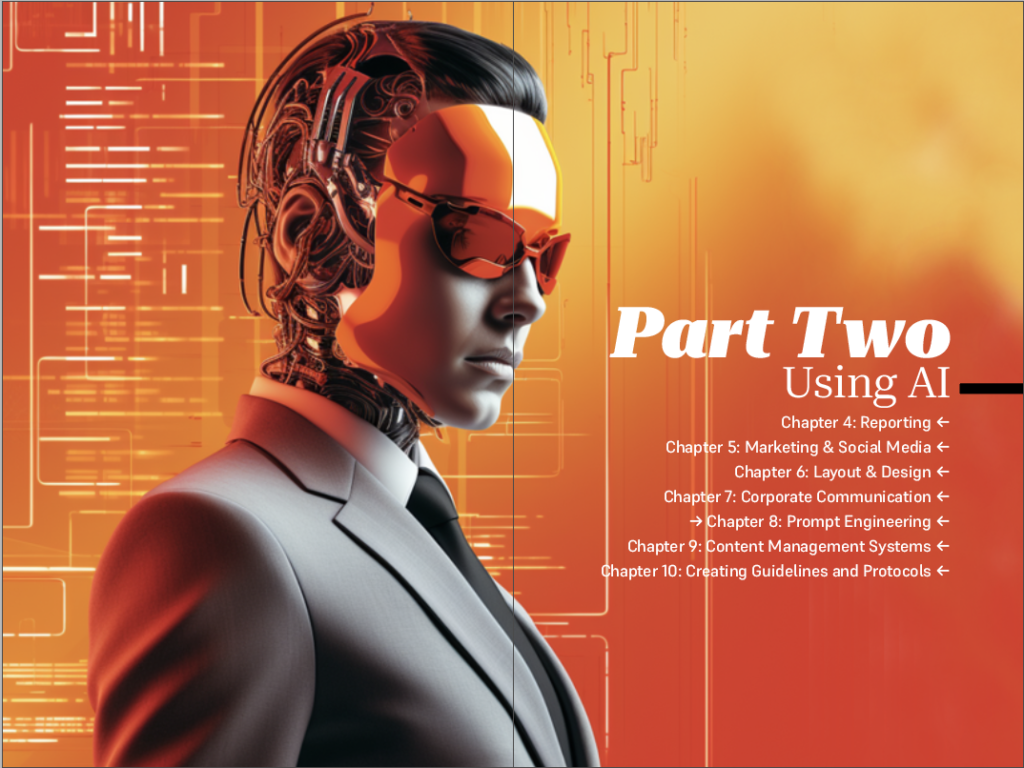
Here is a chance to pre-order my new book about Artificial Intelligence and content creation. The first 25 copies sold will be signed! Order here:
https://thaneandprose.com/…/preorder-ai-what-to-expect…
Pre-publication reviews!
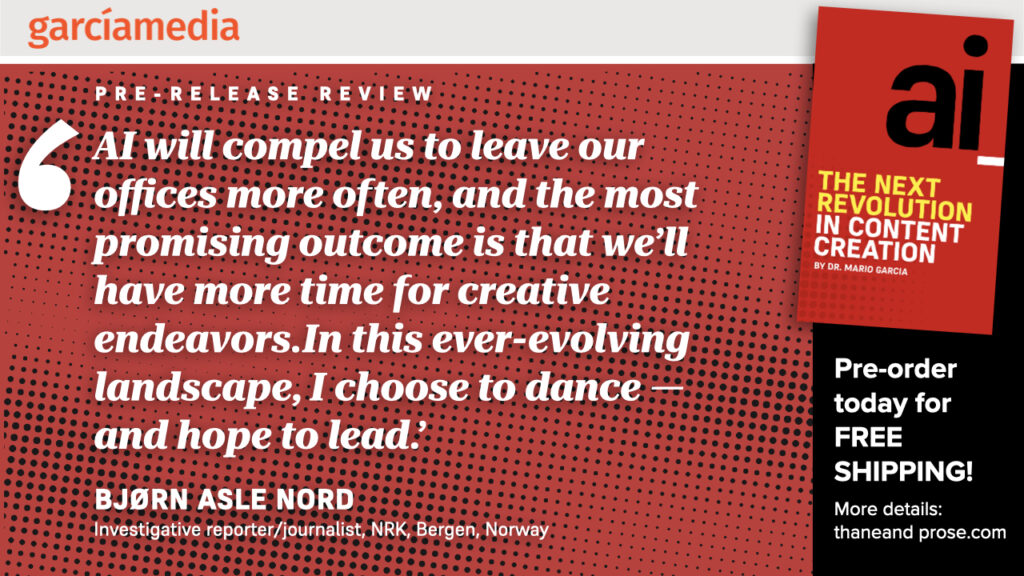
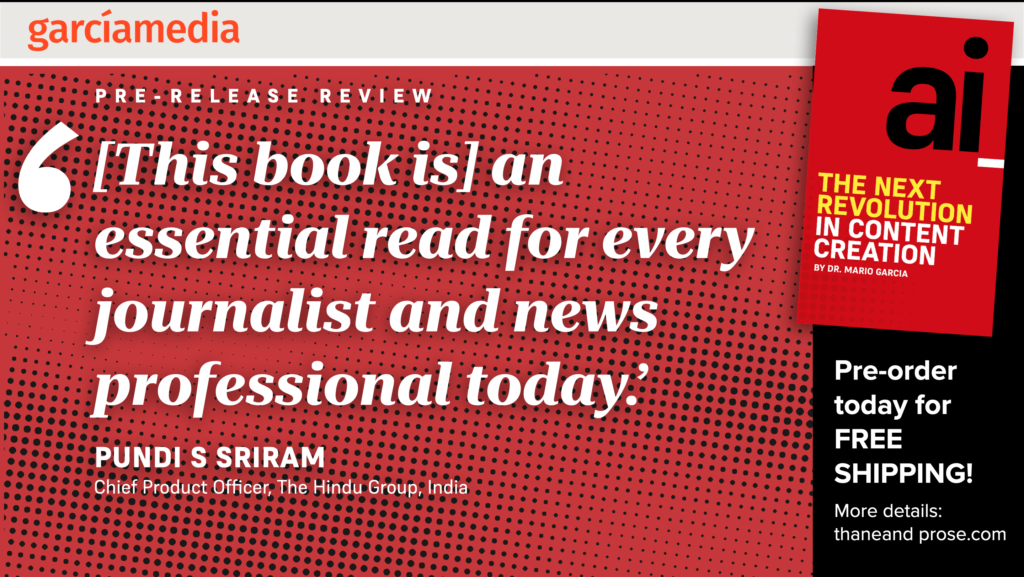
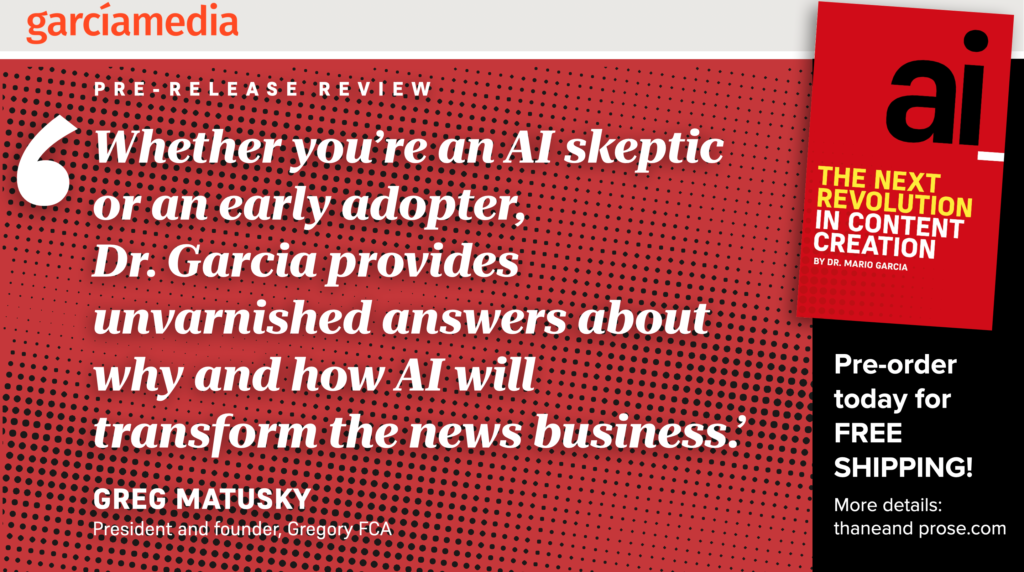

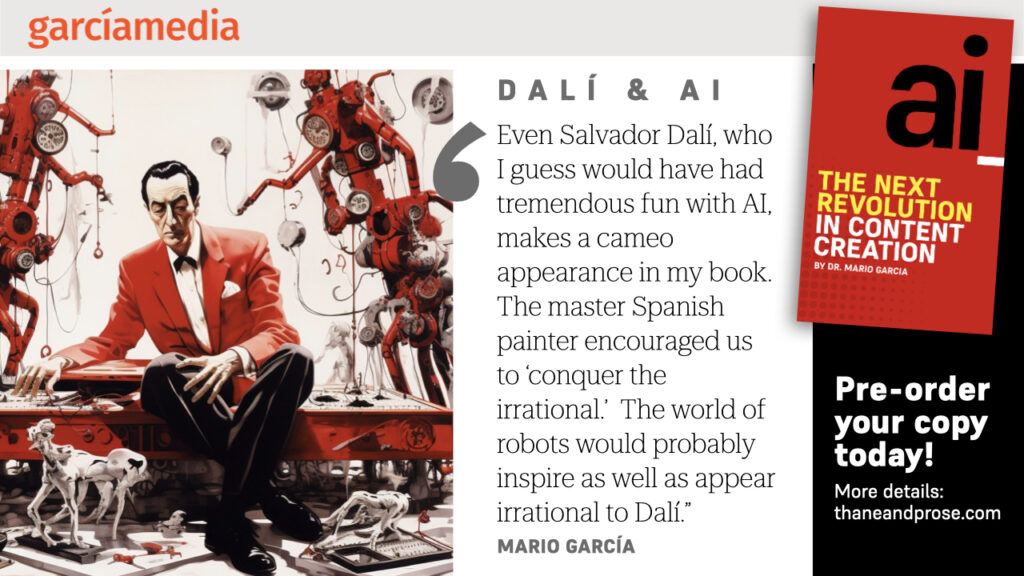
AI front and center
As I put finishing touches on the manuscript of my new book, AI: The Next Revolution for Content Creation, I am aware that the number of AI-related headlines that appear in my mailbox daily is on the increase, frustrating the author of a book that must have a date of completion, and realizing that in today’s fast paced technological advance environment, books must have websites created for updates.
For more about my new AI book, go here:
Of related interest
Newsrooms around the planet have gone mobile-first after a Garcia Media workshop!
Our Garcia Media Mobile Storytelling workshops are proven to introduce your editorial team to the way we write, edit and design for mobile platforms. It is a one-day program that involves a presentation (where I summarize my Columbia University class content), and follow it with a hands on workshop.
Did you read The Story yet?
I urge you to consult my latest book, The Story, a trilogy full of tips and explanations about mobile storytelling, which represents the latest genre for journalists to explore. See information below:
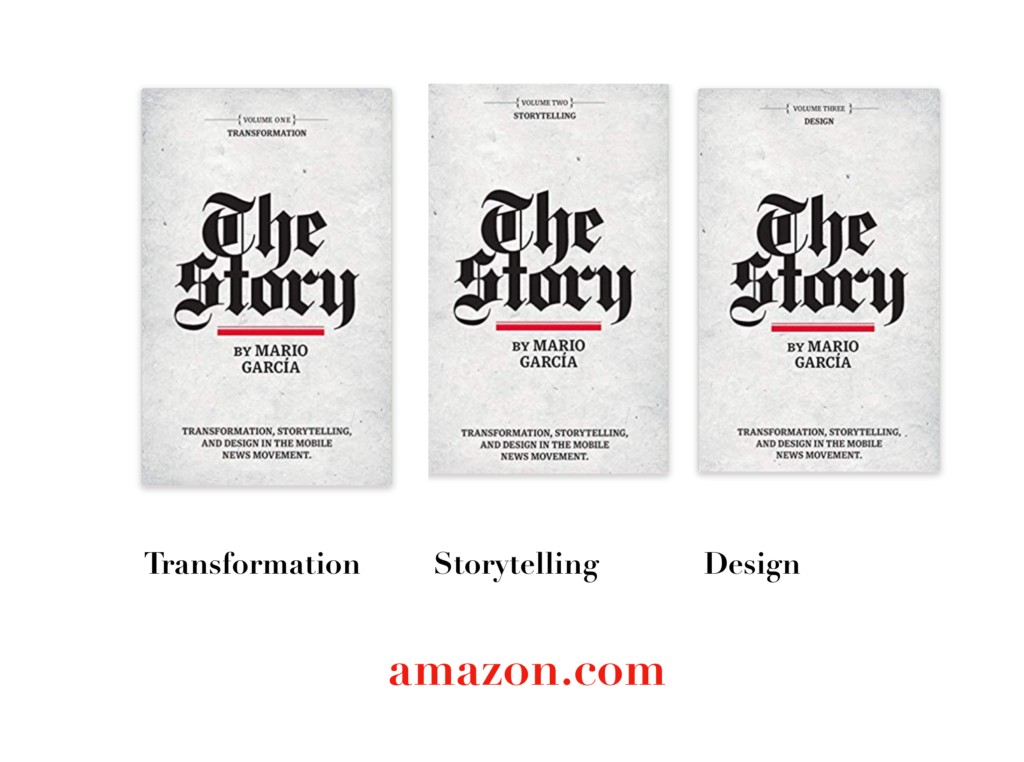
The full trilogy of The Story now available–3 books to guide you through a mobile first strategy. Whether you’re a reporter, editor, designer, publisher, corporate communicator, The Story is for you! https://amazon
Volume 1: Transformation
Volume Two: Storytelling
Volume Three: Design
Order the print edition of The Story, from Amazon, here:
The Story, en español:
TheMarioBlog post #3380